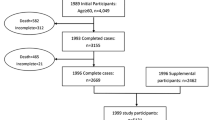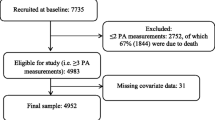Abstract
Background
The significance of physical activity has been noticed. However, the dynamic change and the heterogeneity of physical activity patterns among older people are little explored.
Purpose
This study aimed to identify the trajectory patterns of engaging in physical activity over time and its related factors.
Method
Nationally representative four-wave panel data from Taiwanese older adults, gathered between 1996 and 2007, were used (n = 4,018). The participants ranged in age from 50 to 96 years old. “Being physically active” was defined as performing physical activity in sports or exercises at least three times per week and lasting for at least 30 min each time. Group-based trajectory analysis was performed for analyzing the data.
Results
Four trajectory patterns were identified: inactive (47.83 %), decreasing (12.21 %), increasing (23.36 %), and active (16.60 %). Older respondents and those with more education were more likely to be active. Those respondents having more depressive symptoms, having more physical functional limitations, and having jobs were less likely to be physically active in the decreasing, increasing, and active patterns.
Conclusion
There is heterogeneity among the trajectory patterns of physical activity across time in the older adults. Different strategies of physical activity promotion for the older people should be developed by the group characteristics.

Similar content being viewed by others
References
WHO. Global recommendations on physical activity for health. Geneva: World Health Organization; 2010.
U.S. Department of Health and Human Services. Physical activity guidelines for Americans. Hyattsville: U.S. Department of Health and Human Services; 2008.
U.S. Department of Health and Human Services. Healthy people 2020: leading health indicators: nutrition, physical activity, and obesity. 2013. http://www.healthypeople.gov/2020/LHI/nutrition.aspx?tab=data. Accessed 3 May 2013.
Barnett TA, Gauvin L, Craig CL, Katzmarzyk PT. Distinct trajectories of leisure time physical activity and predictors of trajectory class membership: a 22 year cohort study. Int J Behav Nutr Phys Act. 2008;5:57.
Droomers M, Schrijvers CT, Mackenbach JP. Educational level and decreases in leisure time physical activity: predictors from the longitudinal GLOBE study. J Epidemiol Community Health. 2001;55(8):562–8.
McAuley E, Hall KS, Motl RW, White SM, Wójcicki TR, Hu L, et al. Trajectory of declines in physical activity in community-dwelling older women: social cognitive influences. J Gerontol B Psychol Sci Soc Sci. 2009;64(5):543–50.
Petersen CB, Thygesen LC, Helge JW, Grønbaek M, Tolstrup JS. Time trends in physical activity in leisure time in the Danish population from 1987 to 2005. Scand J Public Health. 2010;38(2):121–8.
Shaw BA, Spokane LS. Examining the association between education level and physical activity changes during early old age. J Aging Health. 2008;20(7):767–87.
Slingerland AS, van Lenthe FJ, Jukema JW, Kamphuis CB, Looman C, Giskes K, et al. Aging, retirement, and changes in physical activity: prospective cohort findings from the GLOBE study. Am J Epidemiol. 2007;165(12):1356–63.
Zimmermann E, Ekholm O, Grønbaek M, Curtis T. Predictors of changes in physical activity in a prospective cohort study of the Danish adult population. Scand J Public Health. 2008;36(3):235–41.
Caspersen CJ, Pereira MA, Curran KM. Changes in physical activity patterns in the United States, by sex and cross-sectional age. Med Sci Sports Exerc. 2000;32(9):1601–9.
Giuli C, Papa R, Mocchegiani E, Marcellini F. Predictors of participation in physical activity for community-dwelling elderly Italians. Arch Gerontol Geriatr. 2012;54(1):50–4.
Lahti J, Laaksonen M, Lahelma E, Rahkonen O. Changes in leisure-time physical activity after transition to retirement: a follow-up study. Int J Behav Nutr Phys Act. 2011;8:36.
Stathi A, Gilbert H, Fox KR, Coulson J, Davis M, Thompson JL. Determinants of neighborhood activity of adults age 70 and over: a mixed-methods study. J Aging Phys Act. 2012;20(2):148–70.
Nagin DS. Group-based modeling of development. Cambridge: Harvard University Press; 2005.
Kohout FJ, Berkman LF, Evans DA, Cornoni-Huntley J. Two shorter forms of the CES-D (Center for Epidemiological Studies Depression) depression symptoms index. J Aging Health. 1993;5(2):179–93.
Nagi SZ. An epidemiology of disability among adults in the United States. Milbank Mem Fund Q Health Soc. 1976;54(4):439–67.
Jones BL, Nagin DS, Roeder K. A SAS procedure based on mixture models for estimating developmental trajectories. Sociol Methods Res. 2001;29(3):374–93.
Estabrooks PA, Lee RE, Gyurcsik NC. Resources for physical activity participation: does availability and accessibility differ by neighborhood socioeconomic status? Ann Behav Med. 2003;25(2):100–4.
Mikkelsen SS, Tolstrup JS, Flachs EM, Mortensen EL, Schnohr P, Flensborg-Madsen T. A cohort study of leisure time physical activity and depression. Prev Med. 2010;51(6):471–5.
Strawbridge WJ, Deleger S, Roberts RE, Kaplan GA. Physical activity reduces the risk of subsequent depression for older adults. Am J Epidemiol. 2002;156(4):328–34.
Teychenne M, Ball K, Salmon J. Physical activity and likelihood of depression in adults: a review. Prev Med. 2008;46(5):397–411.
Korniloff K, Vanhala M, Kautiainen H, Koponen H, Peltonen M, Mäntyselkä P, et al. Lifetime leisure-time physical activity and the risk of depressive symptoms at the ages of 65–74 years: the FIN-D2D survey. Prev Med. 2012;54(5):313–5.
Ströhle A. Physical activity, exercise, depression and anxiety disorders. J Neural Transm. 2009;116(6):777–84.
Koeneman MA, Chinapaw MJ, Verheijden MW, van Tilburg TG, Visser M, Deeg DJ, et al. Do major life events influence physical activity among older adults: the Longitudinal Aging Study Amsterdam. Int J Behav Nutr Phys Act. 2012;9:147.
Caspersen CJ, Powell KE, Christenson GM. Physical activity, exercise, and physical fitness: definitions and distinctions for health-related research. Public Health Rep. 1985;100(2):126–31.
Ainsworth BE, Haskell WL, Herrmann SD, Meckes N, Bassett Jr DR, Tudor-Locke C, et al. 2011 Compendium of physical activities: a second update of codes and MET values. Med Sci Sports Exerc. 2011;43(8):1575–81.
Acknowledgments
The research was supported by grants from the National Science Council, Taiwan, Republic of China (NSC 101-2410-H-468-008-MY2). The data was provided by the Surveillance and Research Division, Health Promotion Administration, Ministry of Health and Welfare. The work of LYP is supported by the Health Policy Research Fellowship funded by the National Health Research Institute (Taiwan) (HP9802). The interpretation and conclusions contained herein do not represent those of the Bureau of Health Promotion. This study obtained approval of the Research Ethics Committee of Central Regional Research Ethics Center, Taiwan (CRREC-101-062). The authors declare there is no conflict of interests.
Author information
Authors and Affiliations
Corresponding author
Rights and permissions
About this article
Cite this article
Pan, LY., Hsu, HC., Chang, WC. et al. Trajectories of Physical Activity and Risk Factors Among Taiwanese Older Adults. Int.J. Behav. Med. 22, 62–69 (2015). https://doi.org/10.1007/s12529-014-9409-3
Published:
Issue Date:
DOI: https://doi.org/10.1007/s12529-014-9409-3




